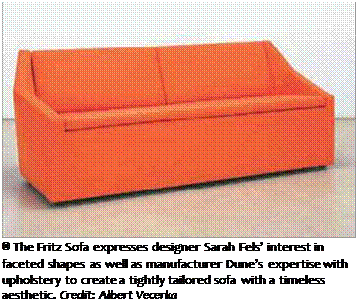 While she often begins her designs with some kind of research, “this had more to do with thinking about poetic inspiration or images that stuck in my mind. I was thinking about a fairly diverse bunch of images, from the deco Chrysler building angularity, to the tech, cubist movement in architecture that produced all these crazy faceted objects and buildings, and also about punk spikiness. I was really interested in a faceted, angular language for furniture.”
While she often begins her designs with some kind of research, “this had more to do with thinking about poetic inspiration or images that stuck in my mind. I was thinking about a fairly diverse bunch of images, from the deco Chrysler building angularity, to the tech, cubist movement in architecture that produced all these crazy faceted objects and buildings, and also about punk spikiness. I was really interested in a faceted, angular language for furniture.”
The ultimate shape of the sofa actually grew out of two other pieces of furniture. “The project really began as an armchair, and from that became an ottoman, and then a sofa,” according to Fels. “That’s not uncommon. When you start working on a project, you think about what else that idea can yield, and turning it into a family. In the context of the armchair, I was thinking about how this angular, formal language could conform to the body and the way people sit. I was thinking about the way a crooked arm and an elbow was shaped and how the chair could reflect that.”
Fels was also keeping manufacturing in mind. While the producer, Dune, was not limited to any particular process, Fels knew that they were particularly skilled with upholstered pieces. “So, I was also thinking about projects that would be, in a way, advanced upholstery techniques, things that would show off what they can do really well.”
To kick off her design process, Fels uses the old-fashioned tools of mechanical pencil and paper and begins to “sketch like crazy.” She says the results usually range far and wide from where she started, but this is important to keep her mind open and her ideas fresh. She then sets the sketches aside for a period of time so that she can review them more objectively at a later date. Then it’s time to sit at the computer. “I start making computer sketches, essentially, but they’re actually renderings of wire frames of the object. And that is an amazing way for me to get to prototype the ideas quickly and find out why something that may have worked as a sketch is not working in 3D,” Fels says. “I start thinking about the actual construction details a little bit and what they might be. But it’s sort of a back-and-forth process, because thinking about the actual production drives the initial thoughts of what the idea can be; there’s always this back and forth between where the form wants to go and what’s possible production-wise. Ideally, the form reflects what the production process is. Those things should not be at cross purposes,” she points out.
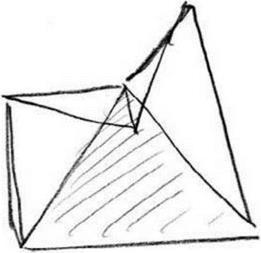
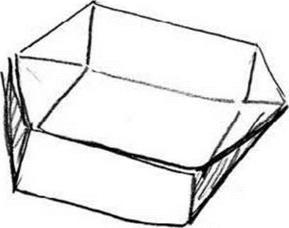
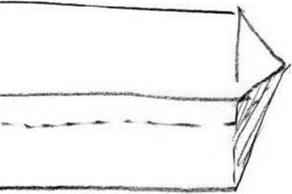 © Early pencil sketches of the Fritz Sofa are the outgrowth of a research phase where Sarah Fels considered technical and production concerns as well as the client brief or direction. In this case, she was given the theme of “future living” and knew she was working with a manufacturer with excellent upholstering skills. Credit: Sarah Fels
© Early pencil sketches of the Fritz Sofa are the outgrowth of a research phase where Sarah Fels considered technical and production concerns as well as the client brief or direction. In this case, she was given the theme of “future living” and knew she was working with a manufacturer with excellent upholstering skills. Credit: Sarah Fels
© After allowing herself to sketch in a range of directions, Fels developed a few of her ideas as computer models. This is a screen grab of a wire frame model made using the application FormZ. Credit: Sarah Fels

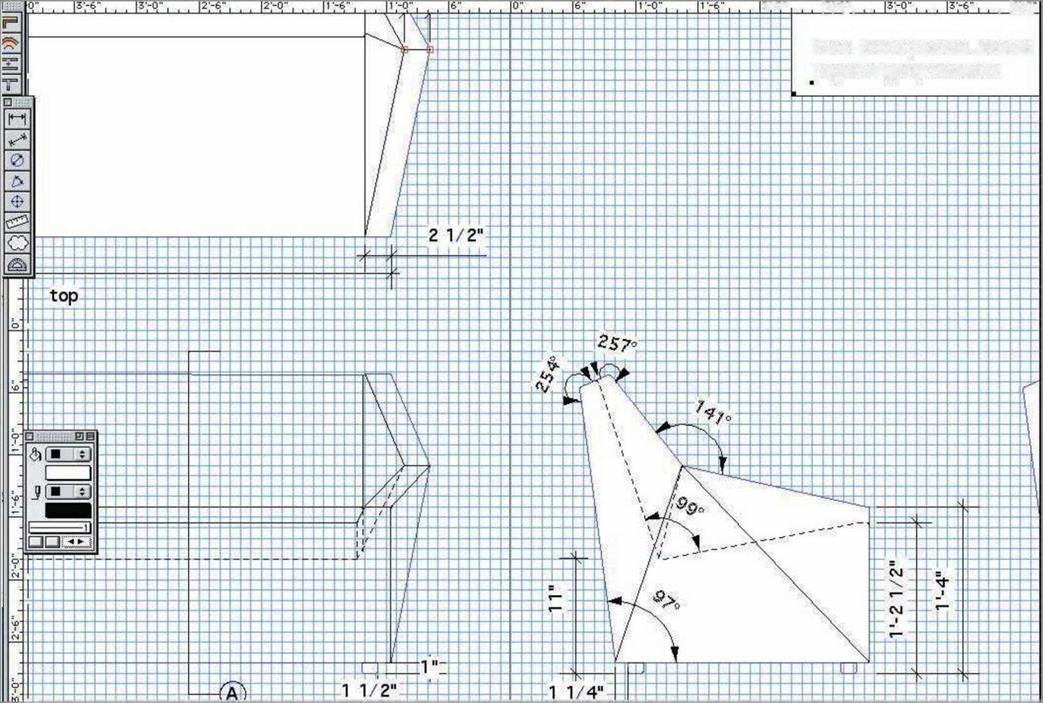 Once she has the form worked out, she presents these renderings to the client, showing the piece from various angles and elevations. She usually shows several ideas at once. In this case, after seeing all the options, Dune asked to return to her very first idea. “I had put it aside and the client came back and said remember that?” Fels recalls. “So we dusted it off. Sometimes it’s not a linear process.”
Once she has the form worked out, she presents these renderings to the client, showing the piece from various angles and elevations. She usually shows several ideas at once. In this case, after seeing all the options, Dune asked to return to her very first idea. “I had put it aside and the client came back and said remember that?” Fels recalls. “So we dusted it off. Sometimes it’s not a linear process.”
While Fels had set out to fully utilize all of Dune’s upholstery capabilities, she didn’t realize just how much of a challenge she was creating. “The formal idea really dealt with surfaces as opposed to the kind of puffy mass of an upholstered thing,” she says. “In upholstery, it’s very hard to get a crisp edge and a tight corner. But on the other hand, there’s this traditional way of building a frame which is padded and sprung and covered in fabric, and that really does lend itself to these odd shapes. It took a lot of patience on the part of the people building it,” she says. Unlike the more typical sofa, where dense cushions can hide a whole range of interior ills, with the Fritz, there was no room for error. “Every angle has to be correct for the whole thing to add up,” Fels notes. “So the hard part was pushing the manufacturer to use all their frame building skills to arrive at what I had in mind. It was imposing a lot on the prototyper’s patience and good will, but it all worked out in the end.”
The solid mass of the sofa is relieved by the small feet peeking through at the bottom, which also addresses an important practical concern: “You always need some sort of foot,” Fels says, “because floors are not even as a rule, and so if you just had the solid mass meeting the floor, it’s almost guaranteed to be tippy. Feet save wear on the mass of the piece, and make it more stable on the floor.” But equally important to Fels are the aesthetic considerations. “The feet also visually make for a somehow more pleasing transition from the object to the floor. Even for architects, there’s always this question of how does the thing meet the ground, and it’s a surprisingly difficult moment to finesse. But just by lifting this big, chunky thing off the ground a bit, you create this illusion that it’s hovering, and it has this mysterious lightness. It’s a more pleasing resolution.”
Overall, the Fritz Sofa reflects both new and familiar design concerns for Fels. While the angularity is a different form than she usually creates, the focus on how the process helps create the form is a consistent theme in her work. “I’m always interested in my design work—not in a no-fun, didactic way—but in designing things that inform the user in some subtle way about how the object is made, or at least provoke an inquiry about how the object is made, and hopefully create some awareness that we live in a built environment. Because that, to me, is the sort of wonderful thing about
|
 |
|
© Using the program VectorWorks, the next phase in Fels’s design process is to create a fully dimensioned mechanical drawing of the furniture piece. This screen grab shows a range of technical details such as angles and dimensions. Credit: Sarah Fels
|
150 DESIGN SECRETS: FURNITURE |
|
In order to get a “clearer understanding of the form and construction issues,” Fels does rendered computer models of her designs that show the real shape and dimension of the piece. Credit: Sarah Fels
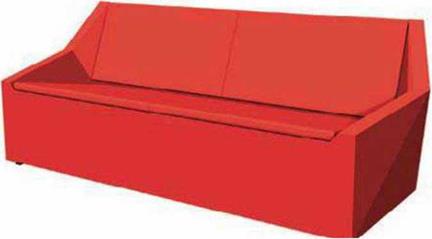
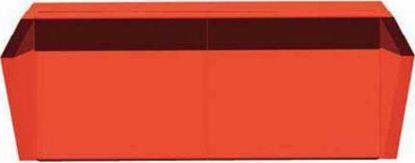
 |
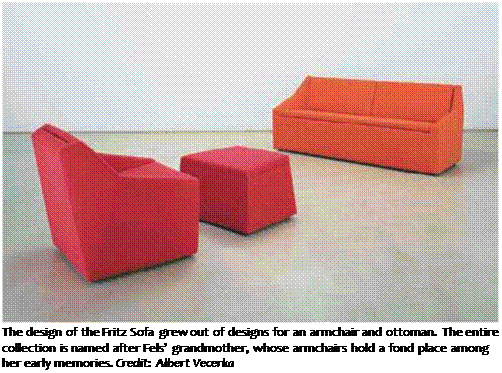
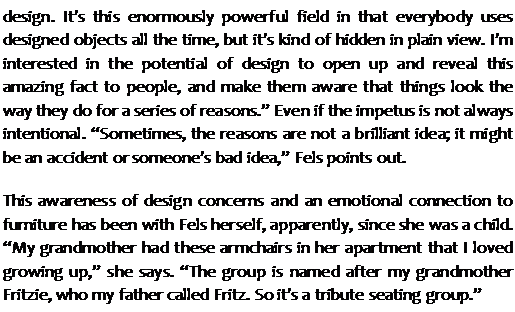 |
In this computer model rendering showing front, back, and side views of the Fritz Sofa, Fels’ interest in faceted shapes, tight corners, and clean upholstery is evident. Credit: Sarah Fels



